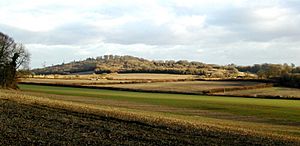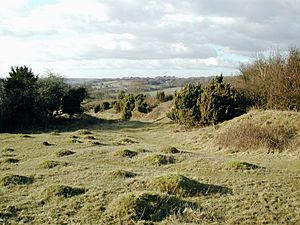Noar Hill facts for kids
| Site of Special Scientific Interest | |
 |
|
| Area of Search | Hampshire |
|---|---|
| Interest | Biological |
| Area | 63.0 hectares (156 acres) |
| Notification | 1984 |
| Location map | Magic Map |
Noar Hill is a very special natural area in Hampshire, England. It covers about 63 hectares (that's like 156 football fields!). This place is known as a Site of Special Scientific Interest because of its amazing plants and animals.
Part of Noar Hill, about 20 hectares, is a nature reserve. It is looked after by the Hampshire and Isle of Wight Wildlife Trust. Noar Hill is also part of the East Hampshire Hangers Special Area of Conservation. This means it's super important for nature in Europe!
Noar Hill is one of the chalk hills that make up the South Downs. It rises to about 210 metres high. Some parts of the hill are very steep, like a really big slide!
A famous writer named Gilbert White wrote about Noar Hill a long time ago. In his book, Natural History of Selborne, he mentioned how two streams start near Noar Hill. One stream flows south towards the Arun River and then to the English Channel. The other stream flows north.
Most of the top of Noar Hill is used for farming. But a smaller part, called High Common, is covered in wild grasses and bushes. This area is about 20 hectares. The sides of the hill are covered in thick woods, mostly with beech trees. These steep, wooded hills are called "hangers" in East Hampshire.
High Common has a cool history! Long ago, in the Middle Ages, people dug out chalk from this area. They used the chalk to make the nearby farm fields better for growing crops. Because the ground became so bumpy from all the digging, it was never ploughed. This helped to save the old chalk grassland plants that are now rare in other places.
Contents
Amazing Plants of Noar Hill
The old chalk diggings at Noar Hill created many different small areas. Some spots are sunny, some are shady, and some are very steep. This means lots of different plants can grow here.
Noar Hill is famous for its "calcicoles." These are plants that love to grow in chalky soil. Some of the special plants you can find here include hairy rock-cress, dropwort, and pale flax. You might also spot common milkwort, marjoram, and wild thyme. Look closely for clustered bellflower and different types of eyebright.
Rare plants like small-leaved sweet-briar have been seen here. There are also four box bushes that scientists think are native to the area. Early gentian, a very rare flower, has also been found growing on the bare chalk. You might even see a parasitic plant called knapweed broomrape. Juniper bushes grow well here, and in spring, the ground is covered in beautiful yellow cowslips.
Sometimes, you can find dragon's-teeth and fern-grass.
Noar Hill's Wonderful Orchids
The most amazing plants at Noar Hill are its orchids! At least eleven different types of orchids have been found here.
- Twayblade
- Autumn lady's tresses
- Musk orchid
- Pyramidal orchid
- Fragrant orchid
- Frog orchid
- Common spotted orchid
- Southern marsh orchid
- Early purple orchid
- Fly orchid
- Bee orchid
Noar Hill has a huge group of musk orchids, with about 10,000 plants! This is very important for the whole country.
High Common is like a safe home for many chalk grassland plants. It's surrounded by farmland where these plants don't grow as well. This means Noar Hill can help other nearby areas get their special plants back. For example, Selborne Common might benefit from this.
Animals of Noar Hill
Noar Hill is also home to many interesting animals. It's the only place in Britain where you can find the unique fairy shrimp. These tiny creatures live in puddles on the paths. When the mud dries up, they survive as eggs until the next rain.
On summer evenings, you might see glow-worms shining their lights over the reserve. Lots of grasshoppers live here, including the rufous grasshopper.
Butterflies and Birds
Noar Hill is a great place to see butterflies. You might spot marbled whites, brown arguses, and the special Duke of Burgundy butterfly. Other beautiful butterflies include the brown hairstreak and the holly blue. Of course, there are many common butterflies too!
You can also find slowworms here. These legless lizards are harmless. The reserve is a breeding ground for turtle doves, which are becoming rare. Green woodpeckers are often seen, as they love to eat ants.
Several pairs of common buzzards live in the area. They often hunt the rabbits on High Common. Sometimes, a hen harrier visits in winter. You can almost always find bullfinches on the hill, maybe because they love eating rosehips!



